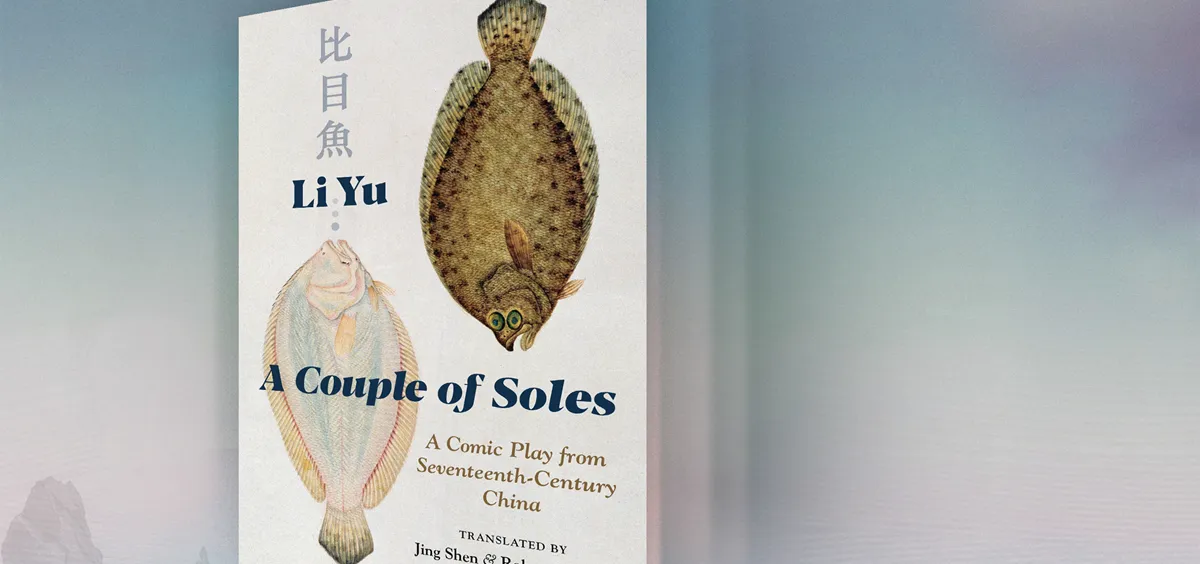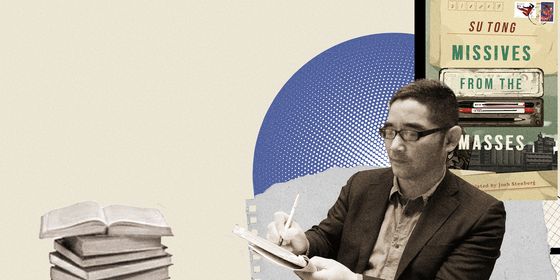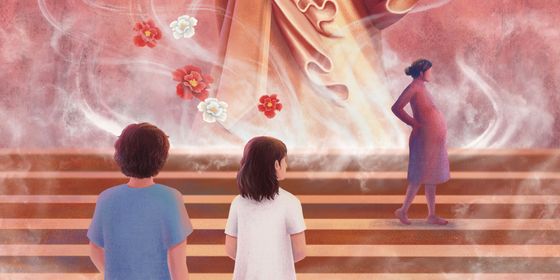A new translation revitalizes a Qing “morality play” about love and corruption for a modern audience
“All the world’s a stage,” Shakespeare observed in As You Like It. Sixty years later, and half a world away, Chinese playwright Li Yu’s epic drama A Couple of Soles (《比目鱼》) would bring new meaning to the phrase, presenting a world of petty corruption and pure love where seemingly everyone is pretending to be someone else.
Originally written and performed in 1661, A Couple of Soles is the first of Li’s 10 plays to be translated into English. This early Qing-era drama offers a compelling tale of romantic surprise, as well as a window into the mind of a talented eccentric and giant of the dramatic tradition in China.
A Couple of Soles begins as the story of a troupe of actors, performing their different roles in the drama of life while submitting to personal crises on stage. At its center is the love between a frustrated young scholar, “child prodigy” Tan Chuyu, and a juvenile actress, Fairy Liu. Introduced as a struggling writer, Tan is swiftly inducted as the play’s noble romantic, so stirred by the 14-year-old Liu’s beauty that he resolves to give up scholarly ambitions for a lowly position in Liu’s troupe in order to be close to her.
Tragically, however, professional ethics initially forbid Tan and Liu from interacting further. They are forced to express themselves solely on stage, reciting verses that hint at their true feelings for one another: “My heart has long been thine/ Secretly I wait for you,” relates Liu during one rehearsal.
Born in 1610, Li Yu (李渔) was a low-ranking official in Jinhua, Zhejiang province, who turned to writing after political turmoil at the wane of the Ming dynasty cost him the chance to take the imperial examinations for a promotion. Eschewing the Chinese dramatic tradition of recycling the classics, Li’s prolific works drew on emotions and interactions from daily life in a dizzying array of genres, from poetry to food writing to short stories. He also served as playwright, actor, producer, and director in his own theater troupe, and owned a bookshop through which he published his writings.
Soles was published during a chaotic period of political transition, as the fledgling Manchu-led Qing dynasty took over from the Ming, and is written in the chuanqi (传奇) style of Ming romantic opera. It is not an overtly political work—like Shakespeare, Li Yu was always more concerned with humanity than commentary—but it does touch on the social controversies of its day, and gleefully satirizes officialdom.
These themes are especially prevalent in the second half of the play, where Li cuts loose from romantic comedy to tackle corruption, social isolation, greed, and the law in his trademark humorous style. The playwright’s skill and innovation as a narrator and creator of dramatic tension is perhaps best exhibited midway through the 32-scene work: After Fairy Liu is told by her greedy mother, “Fallen Angel” Liu, that she intends to sell her to local baron “Moneybags” Qian, Fairy Liu hatches a theatrical plan to commit suicide during her final performance with Tan by throwing herself into a river.
As Tan and Fairy Liu perform a famous scene from 14th century opera The Thorn Hairpin to the assembled audience, the notion that “all the world’s a stage” becomes reality with this portrayal of a play within a play. After Liu casts herself into the water, affirming her “chaste” status in the (real and in-narrative) audience’s eyes, Tan jumps in after her out of sheer instinct.
So far, so Romeo and Juliet—but the plot then takes a distinctly fantastical turn as the pair becomes a couple of flatfish, a traditional symbol of loving couples, only to be retrieved by Murong Jie, a benevolent ex-official turned fisherman.
The second half of the drama involves a farcical legal dispute as Moneybags Qian tries to win back his bride-price from Fallen Angel Liu after her daughter’s “suicide.” His materialism is contrasted with the incorruptible Murong Jie, who lives in splendid isolation in the mountains and compares his lifestyle favorably against the immorality of officialdom: “The sensible man must put away the drums and gongs in scenes of excitement and never wait until he reaches the state of desolation to take off his official hat and belt.”
By the time Soles was performed, Li was already known for pushing social boundaries with his writing. His 1651 play The Fragrant Companion told a story about female homosexuality, while his best-known work is The Carnal Prayer Mat, a classic of erotic Chinese literature published under a pseudonym in 1657. The latter has proved a perennially controversial work, and, like much of Li’s oeuvre, was periodically banned after his death. Indeed, some of its content would push the boundaries of modern Chinese censorship were it published nowadays.
Soles was far less controversial, though no less popular, perhaps because the narrative is so compelling. As the story progresses, its complex nature becomes apparent, with multiple characters and narrative threads. That Li is able to bring these threads together without any sense of drift, is a testament to his dramatic prowess. That he manages to do so while incorporating a healthy dose of wit and social commentary is perhaps what made him so successful while he was alive—few other writers’ works of the time were as widely read or performed as Li’s.
Li’s own regard for integrity is evident in the portrayal of both Moneybags and Murong Jie, and the court officials who are satirized for attempting to skim money from the lawsuit. His message does not bother with nuance: There are, Li suggests, too many Moneybags in the world, and not enough Murongs. In the end, the money evades them all, as officials of ever-increasing rank requisition the bribes, the bride-price, and other funds for themselves, with no end in sight. Li’s narrative may be complex, but his characters, despite their multiple roles and pretenses, are remarkably pure at heart, even to the point of caricature.
The English translation is published with accompanying footnotes, along with an introduction and appendix by translator Jing Shen to make the work more accessible. The latter are essential reading for all who are not intimately familiar with the musical structure, performance style, and character roles of Qing dynasty opera. For example, the text doesn’t refer to characters by name, but rather by role: sheng, the male lead; chou, a comic figure; and jing, a powerful male role also known as “painted face.” The footnotes are similarly indispensable, as Li invokes ancient poetry, twists traditional idioms, and refers to old folk tales throughout.
Should any not have grasped it, Li makes clear his agenda in the play’s final lines: “All would blame the theater for promoting what is lewd/ I hoped to use the stage to uphold integrity and righteous deeds.” In Li’s time, acting was considered a lowly profession, and those who profited from the arts, rather than engaging in artistic pursuit for its own merit, were frowned upon. Li’s personal circumstances meant that such an avenue was unavailable to him, and he instead created unashamedly popular works that commanded a wide audience.
A Couple of Soles posits that there’s a bit of the thespian in all of us. Far from demeaning the profession, the drama gives its noblest act, Fairy Liu’s suicide, to the character of the lowliest standing. Li suggests we should embrace artifice as a fact of life, just as Tan eventually does: “Now finally I am acting the play of my life/ And the opening scene is returning home in glory!”
The Shenzhen Experiment:
The Story of China’s Instant City
Hong Kong-based architect Juan Du aims to dispel the myth that Shenzhen, China’s first and the most successful Special Economic Zone (SEZ), is a rootless city planned on a tabula rasa, making the case that its development model cannot be transferred and copied anywhere. Drawing from rich primary sources and research, the book is an intelligent response to the assumptions about Shenzhen’s success, emphasizing the critical role that regional history and local communities played in the building of this extraordinary city.
Interior ChinaTown: A Novel
Inspired by the author’s experience growing up as the son of Taiwanese immigrants in Southern California, this humorous and heartfelt satire of Hollywood features actor Willis Wu, who dreams of playing a “Kung Fu Guy,” yet continues to get typecast as the “Generic Asian Man.” Drawing upon his work as a screenwriter on HBO’s West World, Yu writes the novel in the form of a TV script. The result is a fun, enjoyable read with clever wordplay and inside jokes, as well as a thought-provoking critique of race, assimilation, and the roles all of us are forced to play.
The Hidden Girl and Other Stories
This second short story collection by the award-winning Chinese-American author and translator Ken Liu (The Paper Menagerie and Other Stories, 2016) covers themes ranging from artificial intelligence to crypto-currency to internet trolling, forming the overarching question, “What will humanity mean when technological singularity is achieved?” Like his last collection, there is no lack of Asian cultural influence in Liu’s work: The title story was inspired by Nie Yinniang, a character created by ninth century Chinese fantasy writer Pei Xing. – Liu Jue (刘珏)
Soles of Wit is a story from our issue, “Grape Expectations.” To read the entire issue, become a subscriber and receive the full magazine.













